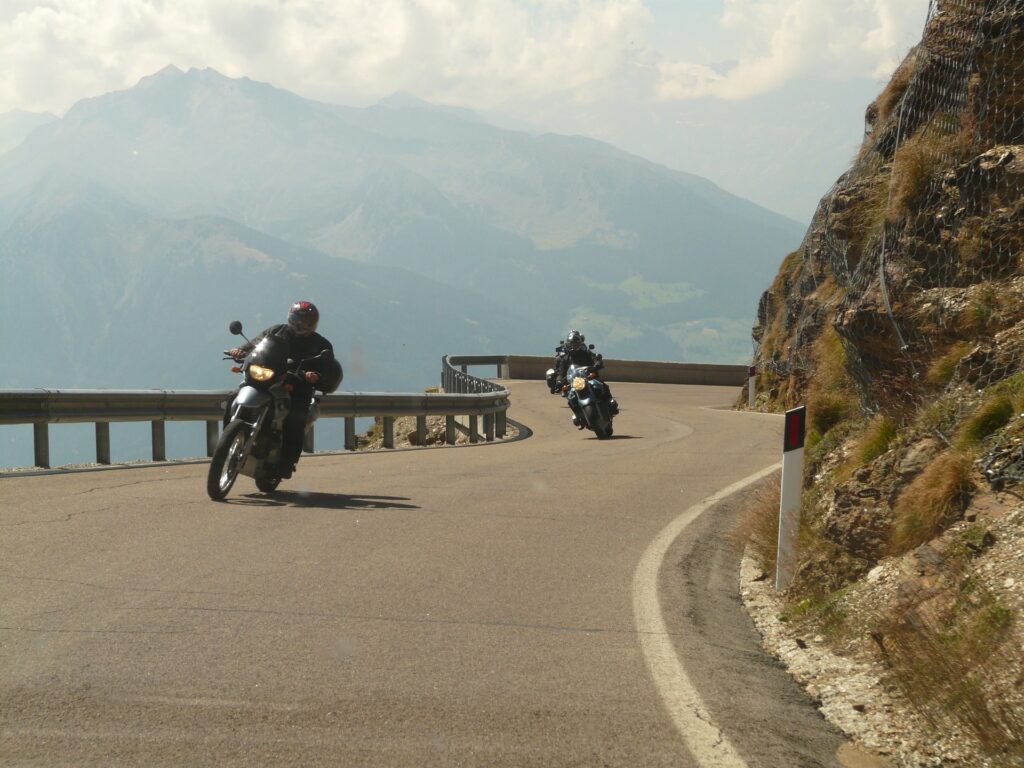How to Master Twisties – Riding The Long and Winding Road

The sensations of riding Twisties can vary from rider to rider but commonly include a sense of thrill and excitement from the rapid changes in direction and speed. The engine’s purring, the calm wind rushing past your body, the adrenaline as you lean into turns, and a heightened sense of focus and awareness as you navigate the winding road.
These sensations can be attributed to a combination of factors, but none as important as being aware of the environment and in complete command of your motorcycle.. If you’re constantly struggling to remain in control, you will miss out on the rewards of riding Twisties. They need to be approached with skill.
Watching athletes perform with grace is a pleasurable experience because it combines physical skill with artistry, creating a sense of beauty and elegance in the way the athlete moves. This fluidity and precision of movement make their sport look effortless. This should be your goal, to gracefully navigate the Twisties. For this, you will need to understand the following concepts and techniques.
Theory
Keep in mind that the specific techniques for approaching a curve vary depending on the angle and radius of the curve and the road and weather conditions.
The Trajectory
The trajectory of riding a curve involves the following phases:
- Entry phase: This phase begins when you start to enter the turn and ends when you reach the point of maximum lean. The bike needs to be on the outside position of the curve (O.M.O.).
- Apex phase: This is the midpoint of the curve where you get the tightest point of the turn. During the apex, the motorbike drops inside the turn (O.I.O.). Except with a blind curve, a section of road that bends in such a way that you cannot see what lies beyond the bend. Blind curves are particularly common on winding or hilly roads. In this situation, the bike falls to the middle of the curve (O.M.O.).
- Exit phase: This phase begins after you pass the apex and ends when you exit the curve. During this phase, the motorcycle returns to the outside position (O.M.O.).
The Approach
Approaching a turn on a motorcycle involves the following principles:
- Reducing speed: When approaching a curve, the forces acting on the bike change. If the bikes speed is too high, maintaining control and avoiding overshooting can be challenging.
- Looking through the curve: Looking through the curve helps to maintain a smooth and safe path through the bend. It allows you to position your bike for the best line through the turn, which increases stability and reduces the risk of losing control.
- Leaning your body and bike: Leaning into a curve helps you maintain balance and control of the motorcycle. The centrifugal force generated during the turn can cause the bike to lean to the outside of the curve. By leaning into the turn, you balance the forces acting on the bike, keeping it upright and stable.
- Maintaining a steady speed: Maintaining a steady pace through a curve allows for better control over the motorbike. Sudden acceleration or braking can upset the bike’s balance.
- Accelerating gradually as you exit the turn: Gradual acceleration allows the tires to maintain better contact with the road surface as the extra speed effortlessly and smoothly uprights the bike in preparation for the next twist.

The Skills
As your riding skills develop, you will feel more confident in your abilities, and ride more smoothly and efficiently, allowing you to fully enjoy the freedom, adventure, and excitement of pivoting through Twisties. In realizing your skill level, you become aware of your limitations, which is crucial in safe, graceful riding.
Developing the following skills can be helpful, and early Sunday morning empty parking lots are some of the best places to improve riding techniques.
Braking:
Braking: Smooth braking on a motorcycle is essential for maintaining control and stability while slowing down before a curve. When braking, apply the brakes progressively rather than grabbing them all at once. This will help to maintain stability and avoid skidding or locking up the wheels.
Trail braking is a motorcycle riding technique where the rider continues to apply the brakes while entering a turn. This technique can slow down and lean the motorcycle during a turn, especially in tight or fast-paced turns.
The key to trail braking is to smoothly transition from braking to turning. The rider applies the brakes, reducing speed, and then smoothly releases them as they turn into the corner. Doing this allows the rider to maintain control and stability during the turn and negotiate the corner more effectively.
Trail braking is a more advanced riding technique, and it’s important to have a good understanding of basic motorcycle braking and cornering skills before attempting it. Additionally, trail braking should be used judiciously, as it can cause the wheels to lock up if done improperly.
It’s also important to be aware of road and traffic conditions when using trail braking. On slippery or loose surfaces, it’s best to avoid trail braking and use traditional braking methods instead.
Lean:
Motorcycle lean refers to the angle at which a motorcycle tilts to one side or the other when turning. This lean is necessary for a bike to maintain its balance and negotiate turns effectively.
To lean a motorcycle, you must shift your body weight in the direction of the turn while also counter steering in that direction. This creates a counterbalance that allows the bike to turn smoothly and safely.
Counter Steering:
Counter steering is a critical riding skill that allows you to make quick and smooth turns in tight spaces, such as on twisty roads. The technique initiates the turn. It involves pushing on the handlebars in the opposite direction of the turn you want to make. This may sound counter-intuitive, but it is a vital part of motorcycle handling.
When you push the right handlebar, the motorcycle’s front wheel will turn to the right, and the bike will lean to the right. As the motorcycle lean reaches a certain point, it will naturally begin to turn in that direction. The same is true when turning left.

Putting it All Together:
There is no set time or experience level when a motorcyclist is ready to ride Twisties, as this depends on several factors, such as riding experience, skill level, motorcycle type, and personal comfort level. Nonetheless, eventually, your first time will arrive and it’s important to remember that navigating Twisties can be challenging and demanding, both physically and mentally. Taking time, riding comfortably, and prioritizing safety are essential. If you feel unsure about your skills or the road conditions, it’s best to slow down or pull over and take a break. However, here are some general guidelines to consider:
Plan your route: Before you hit the road, research the route you plan to take and note any areas that may be particularly challenging, such as sharp turns or steep inclines. Do a trial run of the planned route.
Get in the right gear: Ensure you wear appropriate riding gear, including a helmet, gloves, protective jacket and pants, and sturdy footwear. Ensure the equipment is in good condition and fitted correctly.
Check your motorcycle: Make sure your bike is in good condition before you hit the road. Check the brakes, tires, suspension, and other vital components to ensure everything functions correctly.
Stay focused: Inattention and distraction can be fatal. Stay focused on the road and avoid distractions like your phone or other devices. Keep your eyes on the road ahead and be aware of your surroundings. If your attention is diverted, it could affect how quickly you react when a split second counts.
Use proper body positioning: Good body positioning is key. Keep your body relaxed and centred over the bike, and use your knees to grip the tank while keeping your elbows slightly bent as you lean into the turns. This helps you stay in control of your motorcycle. Pay attention that your feet are not moving forward on the foot-pegs, they can strike the asphalt as the bike leans into the turn.
Brake early: Slow down before entering a turn, not in the middle. This allows you to maintain control and stability while you navigate the turn smoothly. Downshift and/or use the brakes carefully and avoid over-braking, which can cause the bike to skid.
Look through the turn: Your eyes play a crucial role in taking turns. When entering a turn, look through the turn, and focus on the road ahead in the direction you want to go, not at the road’s edge. This will help you to anticipate the turn and assist your body and bike in following the same path.
Avoid sudden movements: When manoeuvring through curves, it’s essential to avoid sudden movements. Keep your actions smooth and controlled to maintain balance and stability.
Slow down: Take it slow when navigating Twisties. You don’t have to go as fast as you can to enjoy the experience. Slowing down gives you more time to react and make decisions.
Practice: Practising your turning skills in a parking lot may not prepare you for the hazards of twisties, but it can help develop your braking skills and the body and eye position.

In a Nut Shell
In conclusion, the many pleasures of riding Twisties make it a popular activity for many motorcycle riders. Whether it’s the scenic beauty, the physical and mental challenge, the camaraderie, or the sense of accomplishment, winding roads offer a unique and thrilling riding experience. However, it’s essential always to prioritize safety and be aware of your surroundings while riding. Eventually, the new skills you will develop become second nature, but until then remember to:
- Plan and evaluate the route and weather.
- Inspect and make required adjustments to your bike and equipment.
- Slowdown accordingly when approaching the turn
- Counter steer, look, and lean through the turn.
- Keep speed constant.
- If necessary, accelerate as you exit.
- Remember, In slow / Out Fast.
- Remember the acronym’s O.I.O. (Outside, Inside, Outside). In blind turns, use O.M.O. (Outside, Middle, Outside)
- Ride within your limits.
- Enjoy!



